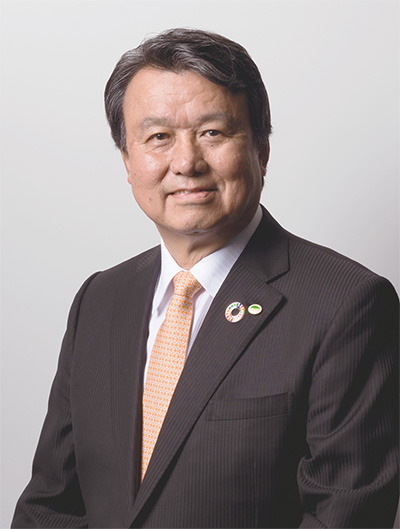COVER STORY:MESSAGE
Product Businesses that Carry on the Founding Spirit of Hitachi
The Industry sector is equipped with a combination of OT, IT, and products. How does this sector contribute to advancing Hitachi's Social Innovation Business and increase the three values set out in Hitachi's 2021 Mid-term Management Plan? Masakazu Aoki, Executive Vice President, talks about the structure of the Industry sector and its future.
 Masakazu Aoki
Masakazu Aoki
Executive Vice President and General Manager of Industry Business Division, Hitachi, Ltd.
After consolidating its 14 existing business units into four areas in April 2017, Hitachi went on in April 2019 to reorganize its business operations around the five key sectors of Mobility, Smart Life, Industry, Energy, and IT. By focusing on its Social Innovation Business that combines operational technology (OT), IT, and products, and by supplying digital solutions that use Lumada, Hitachi has set out to help its customers achieve greater social, environmental, and economic value.
The Industry sector, for which I have responsibility, is one where Hitachi can demonstrate its particular characteristics and strengths, being equipped as we are with a combination of OT, IT, and products for serving industrial customers.
The Industry sector is made up of four operational units: the Industry & Distribution Business Unit, the Water & Environment Business Unit, Hitachi Industrial Products, Ltd., and Hitachi Industrial Equipment Systems Co., Ltd.
The Industry & Distribution Business Unit and Water & Environment Business Unit operate solution businesses based on digital technology and utilities respectively, while the industrial product businesses of Hitachi Industrial Products and Hitachi Industrial Equipment Systems support these operations with non-mass production products and mass-production products respectively.
Along with strengthening the business infrastructure for non-mass production products, the 2018 Mid-term Management Plan also included both a greater role for collaborative creation with customers to help expand digital solutions and the establishment of a firmer foothold for global growth through measures such as the acquisition of Sullair, LLC, a US air compressor manufacturer.
The 2021 Mid-term Management Plan built on this by laying out three growth strategies.
The first strategy is to draw on the strengths of the Industry sector where it has a full range of products, IT, and OT to establish a vertical business model that fuses the cyber and physical realms and links them together via digital technology. The second strategy is to achieve global growth with a focus on the key regions of North America, China, and other parts of Asia where markets are large and steady growth is anticipated. The third strategy is to expand the business further by spreading Hitachi’s large customer base across the different Industry sector companies and supplying products and solutions to new customers and new layers.
Hitachi’s founder Namihei Odaira (1874 to 1951) was an electrical engineer. During the latter years of the Meiji era when electricity was beginning to enter wider use but most electrical machinery was still imported, Odaira embraced a dream of boosting Japan’s industrial development by manufacturing such machinery itself.
He succeeded in building a 5-HP electric motor in 1910, what was to be the founding product of Hitachi. Odaira and his colleagues honed their skills and enhanced quality to create a wider range of products using their own technologies. This steady progress culminated in Hitachi’s corporate credo of “contributing to society through the development of superior, original technology and products.”
Without losing sight of Hitachi’s origins, and without compromising our product business that has a history stretching back more than 100 years, encompassing transformers, compressors, and pumps as well as the electric motors that were Hitachi’s founding product, we have continued to deliver the value demanded by modern society by utilizing the latest materials and other technologies to enhance these products.
Furthermore, Hitachi intends to utilize its portfolio of products that are based on the latest communication and control technologies to deliver the Internet of Things (IoT) and IT in an integrated manner in the form of Lumada solutions. By doing so, we will help bring about a data-centric society in which these products not only fulfill their intended purpose, but also act as the sensors that make up a connected world.
While there has been much talk in recent years about the shift from tangible (physical products) to intangible goods (services, experiences, etc.), by bringing its combined capabilities to bear on strengthening its capacity for supplying superior technologies and the products that use them, delivering a shift from the tangible to a mix of tangible and intangible goods, Hitachi believes that it can help enhance value for customers, society, and the environment.
The respective “product-out” and “market-in” approaches to business are a subject of frequent discussion.
The term “product-out” has often been employed in a negative sense in recent years, being used to indicate an approach to manufacturing that is biased towards what the manufacturer wants to or is able to produce, prioritizing their considerations over the needs of the market and customers when undertaking development.
“Market-in,” in contrast, has acquired the positive connotation of focusing on what markets and customers are asking for. However, the two terms cannot be separated quite that easily. At a time of increasingly diverse needs and more complex values, the manufacturing industry is throwing up numerous disruptive technologies, and the claim could be made that deciding what is really needed and predicting what will happen next are becoming more difficult than ever. What is beyond doubt is that, in this environment, products created based on in-depth market research tend to be undifferentiated or else constrained within the limits of past thinking.
What Hitachi is seeking to do is to adopt an innovative product-out approach that plays to its strengths while also paying attention to the market.
This issue of Hitachi Review presents the activities in which Hitachi is actively engaged, focusing on companies Hitachi Industrial Products and Hitachi Industrial Equipment Systems, which develop products for industrial customers. I look forward to hearing opinions from readers.